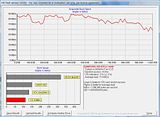Morning all. just a quick question. i've ordered a 250gb hdd for my laptop and was wondering if this Theory works on laptop hdd's? if so do i simply create two partitions? first one being the actual OS partition?
Morning all. just a quick question. i've ordered a 250gb hdd for my laptop and was wondering if this Theory works on laptop hdd's? if so do i simply create two partitions? first one being the actual OS partition?
on a 250gb drive. how much space should the first partition(OS) be?
Fat 32 partitions deliver data faster than NTFS partitions. So it should give a double benefit using the first 32gb of your drive for your OS formatted as FAT32.
All Hail the AACS : 09 F9 11 02 9D 74 E3 5B D8 41 56 C5 63 56 88 C0
All Hail the AACS : 09 F9 11 02 9D 74 E3 5B D8 41 56 C5 63 56 88 C0
Interesting...
Have some more data:
This is a now 3.5 year old PATA 200Gb 7200rpm 8Mb cache Maxtor drive with a windows install that's just as old. The disk manager shot is to show the order of the partitions, which I only really did to keep the windows install away from everything else.
Re-testing varies the numbers but the system partition is always faster than the larger one.
Whats the best way to format a 1Tb Samsung F1, bearing in mind that this will be in an external eSata casing and that I will not be booting from this.
3 equal partitions? or some other config?
'All days should be weekends...i'd never complain then'
Try using HDTach to get a profile of how the access rates deteriorate as you get further 'into' the disk. That is the best way to determine the best positions, in my opinion.
Here's my HDTach & HDTune - taken from 1Tb Samsung F1 in an external Icy Box 390 enclosure connected to my XPS M1530 via eSata expresscard.

I'm not really sure what I should be looking for in this to help me set the partitions right (bearing in mind I won't be booting from this and it will be a data drive only). Recommendations / Advise more than welcome...
'All days should be weekends...i'd never complain then'
I don't have HDTach on here, but I think there might be a setting change available to get more readings, and hence a more clear trendline.
What sort of data are you intending to use the drive for? If it is just for regular storage of assorted files, then there is little real point in following Zak's guide. The benefit only really comes when you require extremely rapid access to some files, such as with an operating system or with heavy video and music editing work.
There are currently 1 users browsing this thread. (0 members and 1 guests)